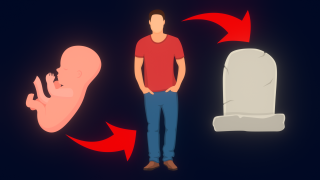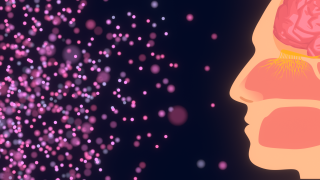The Language YOU Speak But Don't UNDERSTAND
Published: February 1, 2025 at 7:38 PM (PT)
8:01
(14450 frames/30fps) Resolution:1920x1080
(FHD) Most Rewatched:2:45 to 3:00 Realtime Statistics...
30 Minutes...
Hour...
24 Hours...
Information Sources
https://www.freshpet.com/blog/can-dogs-sense-human-emotions
Odorhttps://en.wikipedia.org/wiki/Odor
How Far a Dog Can Smellhttps://www.nylabone.com/dog101/facts-about-dogs-sense-of-smell
Dogs Smelling Sensitivityhttps://phoenixvetcenter.com/blog/214731-how-powerful-is-a-dogs-nose
Las Vegas Spherehttps://en.wikipedia.org/wiki/Sphere_(venue)
Silkmoth Sense of Smellhttps://www.discoverwildlife.com/animal-facts/which-animal-has-the-best-sense-of-smell
Needle Size (calculated)Measured at 41mm x 0.7mm x 0.7mm, volume of 20mm³, area of 28.7mm²
Size of a Hay Balehttps://www.machinefinder.com/ww/en-US/faq/hay-bale-dimensions
Size of the Sahara Deserthttps://en.wikipedia.org/wiki/Sahara
How Something Emits a Smellhttps://libraries.colorado.edu/2020/05/01/science-behind-smell-books-explained-preservation
Trail Pheromoneshttps://en.wikipedia.org/wiki/Trail_pheromone
Channel Catfish Pheromoneshttps://en.wikipedia.org/wiki/Channel_catfish
Silkmoths Smelling Distancehttps://www.timescolonist.com/opinion/monique-keiran-silk-moths-scentsibility-is-off-the-charts-4691060
Polar Bears Smelling Distancehttps://www.livescience.com/43673-weird-facts-about-polar-bears.html
Humans Can Detect 1 Trillion Scentshttps://www.science.org/doi/10.1126/science.1249168
Graphic Sources
https://pixabay.com/vectors/person-man-stand-human-arms-legs-8238232
Fetus (Daniel Roberts)https://pixabay.com/vectors/fetus-baby-human-young-small-9412528
Grave Stone (Daniel Roberts)https://pixabay.com/vectors/grave-tomb-tombstone-gravestone-9412527
Human Nose (Daniel Roberts)https://pixabay.com/vectors/nose-face-human-nostrils-smell-9413472
German Shepherd (Daniel Roberts)N/A
Man Standing-Side (Daniel Roberts)https://pixabay.com/vectors/person-man-stand-human-arms-legs-9095533
Dead Pixel (Daniel Roberts)N/A
Las Vegas Sphere (Daniel Roberts)https://pixabay.com/vectors/las-vegas-sphere-venue-building-9412523
Silkmoth (Daniel Roberts)https://pixabay.com/vectors/moth-silkmoth-insect-nature-animal-9413471
Needle (Daniel Roberts)https://pixabay.com/vectors/needle-sewing-metal-crafts-object-9413431
Hay Bale (Daniel Roberts)https://pixabay.com/vectors/hay-bale-straw-agriculture-bundle-9412526
World Map (NASA Visible Earth)https://visibleearth.nasa.gov/images/74092/july-blue-marble-next-generation
Stupid Website (Daniel Roberts)N/A
Donut (Daniel Roberts)N/A
Water Drop (Daniel Roberts)https://pixabay.com/vectors/water-drop-liquid-fluid-nature-8904702
Human Head Cross-section (Daniel Roberts)N/A
Human Brain (Daniel Roberts)https://pixabay.com/vectors/brain-human-anatomy-organ-body-7822205
Crying Face (Daniel Roberts)https://pixabay.com/vectors/crying-emoji-face-expression-head-9389326
Thumbs Up Face (Daniel Roberts)https://pixabay.com/vectors/thumbs-up-emoji-smiley-icon-7648171
Thumbs Down Face (Daniel Roberts)https://pixabay.com/vectors/thumbs-down-dislike-emoji-face-9389330
Tomato (Daniel Roberts)https://pixabay.com/vectors/tomato-food-vegetable-fruit-fresh-8655799
Honeybee (Daniel Roberts)https://pixabay.com/vectors/honeybee-bee-insect-bug-animal-9412521
Ant (Daniel Roberts)https://pixabay.com/vectors/ant-insect-animal-nature-wildlife-8648911
Catfish (Daniel Roberts)N/A
Side-eye Face (Daniel Roberts)https://pixabay.com/vectors/side-eye-glaring-emoji-face-head-9389333
Polar Bear (Daniel Roberts)https://pixabay.com/vectors/polar-bear-mammal-animal-nature-9413469
NowStream (Daniel Roberts)https://blendertimer.com/nowstream
Audio Sources
N/A
Rise of the Enemy (Daniel Roberts)https://pixabay.com/music/main-title-rise-of-the-enemy-full-2-09-14302
Helicopter Flyby (Daniel Roberts)https://pixabay.com/sound-effects/helicopter-flyby-8114
Hit Bang-3 (Daniel Roberts)N/A
Fast-Hit-2 (Daniel Roberts)N/A
To the Galaxy (Daniel Roberts)https://pixabay.com/music/ambient-to-the-galaxy-10734
Escape of Triumph-Epic Cinematic (Daniel Roberts)https://pixabay.com/music/suspense-escape-of-triumph-epic-cinematic-127029
Rumble-1 (Daniel Roberts)N/A
Discord Chime/Notification (L Y)https://www.youtube.com/watch?v=rIPq9Fl5r44
Typing (dawid3292)https://pixabay.com/sound-effects/typing-274133
01-Glass Bottle hit (Daniel Roberts)N/A
Revolution-Epic Cinematic (Daniel Roberts)https://pixabay.com/music/main-title-revolution-epic-cinematic-111025
Hit-3 (Daniel Roberts)N/A
Object Flyby (Daniel Roberts)https://pixabay.com/sound-effects/object-flyby-8115
Fallen Comrade (Daniel Roberts)https://pixabay.com/music/main-title-fallen-comrade-20788
You're currently speaking a language,
a language which you don't even
understand. In fact, you might
not even be able to detect it.
But despite this, you speak this
language 24/7. You speak this
language before you're born and
even after you're dead. You never
stop speaking this language until
you cease to exist. This language
is scent. We normally think of
something's scent as smelling
good or bad, or if you have an
even better nose, you may be able
to tell the difference between
things which stink, smell sweet,
sour, minty and other slightly
more complex smells. But there
is so much more to scents than
just these, so much more in fact,
that you can almost consider
it an entire language. You, whether
dead or alive, are constantly
emitting a certain scent, no matter
how much deodorant you put on
this morning. But did you know
that you actually have relatively
fast control over how you smell?
Well, not like whether are not
you stink, but the other scents
you emit. Mainly, your emotional scents.
Compared to most other mammals,
humans have pretty poor olfaction
(or sense of smell), so we never
notice that someone smells different
when they're scared or angry.
Dogs, on the other hand, can
smell these differences because
they have an incredible sense
of smell. Their sense of smell
is so good, in fact, that they
can smell a person from up to
20 kilometers away or detect substances
at concentrations as low as 1
part per trillion. In human terms,
that's like being able to immediately
spot the one dead pixel on the
Las Vegas Sphere's interior screen.
*clears throat* Sorry, in human
terms, that's like being able
to immediately spot the one dead
pixel on one of 3906 Las Vegas
Sphere interior screens. But if
you think that's crazy, just wait
to you hear about silkmoths. Actually,
no need to wait, 'cause I'm gonna
tell you right now. A male silkmoth
can detect certain smells at concentrations
as low as 1 part per 100 quadrillion.
In human terms, that's like being
able to find a needle in a literal
haystack...*clears throat* a haystack
of 14 billion bales or about like
finding the 3 needles I put in
random places somewhere in the
Sahara Desert or like finding
the actual content on this webpage
that I can't even...
But how does smelling even work?
How does something emit a smell
and what is in my nose that allows
me to somehow detect and generally
identify that smell? Well, that
is about as complex a question
as asking me what I'm doing.
To explain it in a somewhat
basic way, an object emits a smell
or odor because it has volatile
organic compounds, or VOCs. These
compounds easily evaporate at
room temperature, hence the term
volatile. Kind of how water evaporates,
except, unlike water, these compounds
are composed of odorous molecules,
causing the compound to smell.
As the compound evaporates, it
releases these odorous molecules
into the air. Then these molecules
bind to receptor proteins extending
from cilia in your nose which
are connected to olfactory receptor neurons.
This causes electrical signals
to travel from the olfactory nerves
to the olfactory bulb which is
part of the olfactory cortex.
The olfactory cortex is the part
of the brain which processes and
interprets smells. The smells
are largely interpreted by associating
them with memories or emotions
which is why some odors can smell
good to one person and bad to another.
It simply depends on what memory
your brain connects the smell to.
We can tell the difference between
smells because of the signals
sent from the olfactory receptors,
such as what combination of signals
were sent. For example, if I showed
you this sequence of red and white
squares, you'd have no idea what it was.
But if we arrange those squares
like this, you can pretty easily
tell what the squares mean. As
you learn more and more sequences
of squares, you will be able to
quickly identify any number or
shape simply by the sequence of squares.
This is basically the same with smell.
At the beginning of your life
you associate certain signals
with certain objects, such as
food, and then you remember these
connections for years, thus allowing
you to determine what a smell is from.
This is really a gross oversimplification
because there is so much more
that this whole smelling process
involves, but I think if I were
to fully explain it, both you
and I would look something like this.
Anyway, smells can be used as
a way of communicating silently
and invisibly. These types of
odors are called pheromones. Many
animals use pheromones to communicate
between each other. Honeybees
release a pheromone when the hive
is in danger, silently summoning
more bees to their aid. Ants release
pheromones to mark paths to food
sources, thus giving a fast, accurate,
and completely invisible message
to the other ants. Even some aquatic
animals use pheromones. Some catfish,
for example, release a pheromone,
when in danger, which alerts
other nearby catfish. It has been
found that humans also release
pheromones or rather emotion and
mood related scents, the question
is, can we detect them? While
we're pretty certain that humans
can't detect them consciously,
it is still unknown if we can
detect them subconsciously. Have
you ever had that feeling that
someone was watching you, but
you couldn't see anyone, and then
later on you find out that there
was in fact someone watching you?
Pheromones and other smells can
travel insane distances. Some
moths release pheromones which
can travel hundreds of meters
possibly even several kilometers
and polar bears can smell seals
from over 30 kilometers away!
What if humans emit odors which
basically send an invisible message
that tells everything going on
in their mind, such as what they're
looking at, and then you subconsciously
detect those odors so that you
can tell that someone is watching you.
Humans can detect around 1 trillion
different smells, more than enough
smells to get a pretty good idea
of what someone is thinking if
thoughts do indeed produce pheromones.
It sounds completely outrageous,
and for the most part it is,
but we technically haven't proven
that this isn't true. Although,
since animals generally can't
tell if you're looking at them,
and they have much better noses
than humans, it's unlikely that
this is the case. That being said,
maybe they just can't interpret
our odors to know what they mean.
I, personally, feel like there
is something that allows you to
subconsciously detect someone's
presence even at a significant
distance, whether that be the
faintest air currents from their
breath, the faintest temperature
change from their body heat, the
faintest electromagnetic wave
from their brain, or the faintest
scents they're releasing.
Whatever the case, the extremely
complex design of our nose and
brain, and really the whole smelling
process, really demonstrates just
how much stuff is happening all
around us and inside us that we
so easily take for granted. From
the polar bear smelling 30 kilometers
away to the silkmoth with its
3 needles in the Sahara Desert
like odor detection, I feel like
my olfactory acuity is very much lacking.
But at least I'm not stuck in
the arctic being seally or stuck
trying to find a moth in the dark
some hundred meters away by smell.


 February 1, 2025
February 1, 2025 February 1, 2025
February 1, 2025